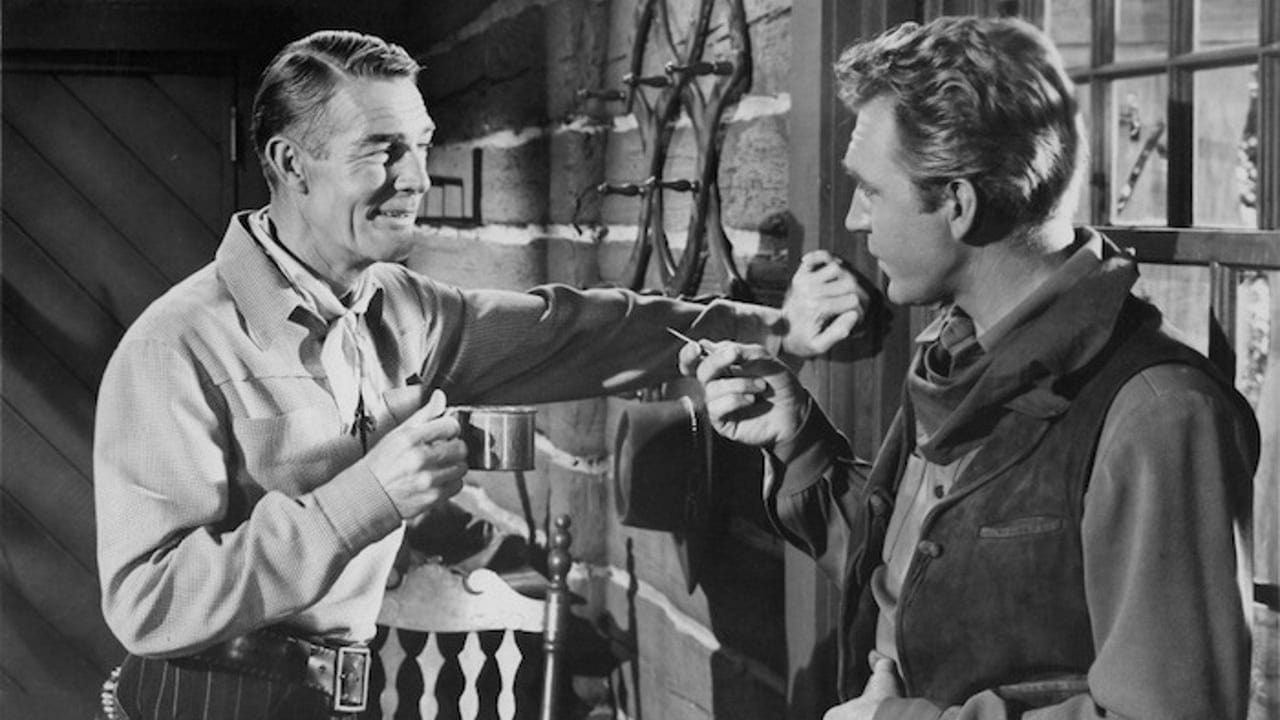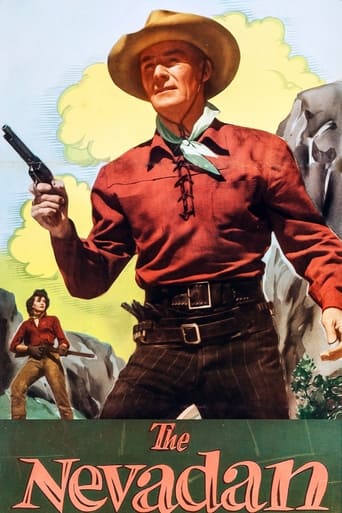

Those who would see the Randolph Scott westerns in the fifties when originally released, would be rewarded with nice colors, more violence than in usual westerns (which would make it more dramatic) and a more mature, rugged faced Scott who combined perfectly with the other elements in the film. The more significant flaws in those films would be in the story but certainly not in this one which has a script which is conventional but good. Forrest Tucker is Tom Tanner who leaves jail and goes straight for the gold he kept. Scott is Barclay, the man that follows him. George Macready is the rancher, and Dorothy Malone is his daughter. Jeff Corey and Frank Faylen are the two brothers who are so good they are even mentioned on the New York Times original review as the best of the film. Good entertainment, and even though the film was made in 1950, it is up to the standards of today.
... View MoreEscaped outlaw Forrest Tucker stops a stranger following him. The stranger is Randolph Scott dressed up like a greenhorn. For no good reason, Tucker decides he needs a partner and Scott fits the bill. This is the kind of plot contrivance you just have to accept from a western like this, a programmer if there ever was one. Naturally, Scott isn't who he says he is. He just wanted to fool Tucker into taking him along so he could find where Tucker hid some gold. There's also an evil rancher, George Macready, who has a pretty daughter. The daughter's played by Dorothy Malone. Of course she and Scott fall for one another. It's all serviceable enough but nothing special. If you've seen enough westerns, all of this movie's pieces will seem familiar. Still, it's a Randolph Scott western. There are far worse ways to pass the time.
... View MoreShot mostly in the spectacular Alabama Hills, with the High Sierras often in the background. The particular variety of granite this region is made of weathers into picturesque combinations of boulders and arches, perfect for playing hide and seek between the good and bad guys. Many of the later Scott-starring firms directed by Budd Boettricher were mostly shot in this region.The plot of this entertaining color western much reminds me of two of Scott's last westerns, shot a decade or so later: "Ride Lonesome" and "Ride the High Country". Each screenplay included two distinct villains or groups of villains, one of whom spent most of the film as Scott's traveling partner, while the other villain(s) was external. This film differs from the other two in that the young woman included didn't form part of the traveling group. However, each film included a young villain as Scott's traveling companion who, at the film's conclusion, is treated as reformed or potentially reformable, hence does not die. In contrast, the external group of villains are characterized as not reformable, and die or run off after the principle villain is killed in a gun battle in which the internal villain participates against the external villains. It's a compellingly interesting plot, thus it's not surprising that it has been recycled in these, as well as some other westerns. Actually, Forest Tucker, at age 30, was a bit long in the tooth for his character(Tom Tanner), who probably should have been in his early 20s.Of the 3 young men in these 3 films, Tanner clearly is the most risky bet for a successful reform, and ends the film with Scott's character, Marshal Andrew Barclay, taking him back to prison for a few more years for his crime of stealing $250,000. in gold. That was a whale of a lot of gold at the price/oz back when this story took place. In fact, he and Barclay hired two mules to carry it all out from its hiding place in an old mine shaft, deep in the Alabama Hills. We are never given any details about the robbery, nor whether Tanner managed to pull off this megaheist by himself(unlikely). Actually, it's difficult to understand why Barclay turns friendly with him in the parting scene, after Tanner repeatedly tried to ditch him as a partner when he thought Barclay was no longer useful to him and threatened to kill him after learning that he was an undercover federal marshal. Their very well staged fight in the gradually collapsing mine tunnel, after together dispatching Galt and his gang outside the tunnel, is doubtless the most memorable sequence in the film. As they fight, they periodically knock down another rotten beam, causing more of the roof to collapse. Barclay pulls the nearly unconscious Tanner out of the entrance, probably saving his life, as the entrance area roof collapses where they just were. Before the fight, Barclay gives Tanner a lengthy lecture on what he best do for his future, which Tanner didn't agree with. For much of the early part of the film, a treasure map that Tanner retrieves from a bank deposit box is a periodic subject of discussion or conflict. But, it turns out to be a bit of a red herring. Galt, who also wants to steal the gold, can't make any sense out of it after he steals the map from Tanner. Tanner later clearly doesn't need it to find the gold, although it may have earlier refreshed his memory about some details. Old Galt is characterized as the stereotypical power-mad crooked 'town boss', who owns most of the key businesses in town, along with a nearby ranch. While he spends his days in town managing his businesses and scheming to increase his wealth, his marriageable daughter Karen(Dorothy Malone) manages the ranch, apparently oblivious to the pathological greed of her father. Initially, when Barclay arrives dressed as a dude from the East, she decided to have some fun by loaning him a notorious bucking horse. but he instead impresses her with his horse taming skill, causing her to gradually warm up to him during their periodic meetings. In the end, after she learns that he is a federal marshal and that her father is intent on stealing the gold from Tanner and Barclay, she switches her loyalty from her father to Barclay, warning her father that she will shoot him if he tries to shoot Barclay for the gold. This is part of the dramatic complex confrontation around the mine entrance. The finale scene in the film hints at a possible marriage with Barclay: a typical ending for westerns of this era. Scott, at 52, still looked young enough to be a plausible suitor for the young women in his films. in contrast, in his films as he approached or exceeded 60, he usually served as more of a father figure.Jock Mahoney, who played Galt's henchman Sandy, sometimes starred in Hollywood and TV films. I remember him as Joe Dakota. He was also a good stunt double, and probably doubled for Scott in the bucking bronco episode and in parts of the mine tunnel fight...Charles Kemper made a memorable town sheriff.I found this film as enjoyable as some of Scott's later higher rated films. It's currently available on You Tube, as well as a print-on-demand DVD.
... View MoreThe Nevadan finds Randolph Scott in a three cornered battle for some stolen gold that escaped outlaw Forrest Tucker has hidden away. After Tucker has made good an escape from authorities, Scott turns up on his trail and proves quite useful. Still Tucker can't figure out why he's turning up all the time and being so helpful.The other part of this mystery is George MacReady who was doing several Randolph Scott westerns at this time. He's a seemingly respectable rancher, but he's got some thugs on the payroll who include Jock Mahoney and bickering brothers Frank Faylen and Jeff Corey ready to do his bidding and he's cutting himself in on Tucker's hidden treasure.Complicating all this is Dorothy Malone, MacReady's daughter, a lovely thing who is totally clueless about her old man. She takes a fancy to Scott and he to her which causes problems for everyone involved.The Nevadan is a good Randolph Scott western that tries for a bit of mystery. The action is good, but the mystery isn't. The people in the film are cast in roles traditional to them so any experienced film watcher can almost predict what will happen.Best part of The Nevadan is the inevitable three cornered shootout at the location of the loot. I think you can figure out who comes out on top.
... View More